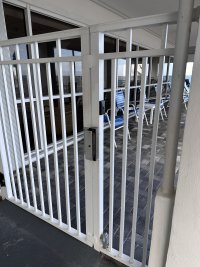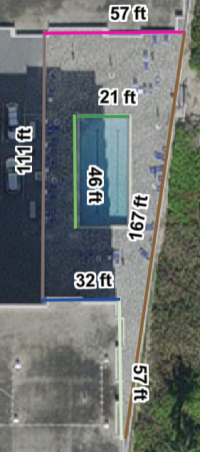-
Welcome to The Building Code Forum
Your premier resource for building code knowledge.
This forum remains free to the public thanks to the generous support of our Sawhorse Members and Corporate Sponsors. Their contributions help keep this community thriving and accessible.
Want enhanced access to expert discussions and exclusive features? Learn more about the benefits here.
Ready to upgrade? Log in and upgrade now.
You are using an out of date browser. It may not display this or other websites correctly.
You should upgrade or use an alternative browser.
You should upgrade or use an alternative browser.
Pool Barrier Gates In Condo
- Thread starter jar546
- Start date
- Featured
fatboy
Administrator
Nope, not for exiting.
1010.2 Door operations. Except as specifically permitted by
this section, egress doors shall be readily openable from the
egress side without the use of a key or special knowledge or
effort.
1010.2 Door operations. Except as specifically permitted by
this section, egress doors shall be readily openable from the
egress side without the use of a key or special knowledge or
effort.
Yikes
SAWHORSE
When you say “IN condo”, do you mean it’s a private pool serving a single condo unit, or is it the common area pool serving many condos?
If the latter and it was in California, you would be required to have free exit away from the pool - - no key or special knowledge required.
If the latter and it was in California, you would be required to have free exit away from the pool - - no key or special knowledge required.
jar546
CBO
Let me clarify. This gate does swing out away from the pool. It is in a common area. There are 3 buildings that share 2 pools. Everything is outside.When you say “IN condo”, do you mean it’s a private pool serving a single condo unit, or is it the common area pool serving many condos?
If the latter and it was in California, you would be required to have free exit away from the pool - - no key or special knowledge required.
Yankee Chronicler
REGISTERED
See fatboy's post, above. The need to use a key fob to exit is not allowed.
jar546
CBO
Is an outside gate for a fence considered a door or egress door?See fatboy's post, above. The need to use a key fob to exit is not allowed.
steveray
SAWHORSE
And it does not seem to meet the latch height requirement...
steveray
SAWHORSE
Is an outside gate for a fence considered a door or egress door?
1010.4 Gates
DiagramGates serving the means of egress system shall comply with the requirements of this section. Gates used as a component in a means of egress shall conform to the applicable requirements for doors.
tmurray
SAWHORSE
If this part of the means of egress, I would certainly allow a designer to treat it like a door. Alternatively, I don't care what it is called. It is simply an obstruction to the means of egress.Is an outside gate for a fence considered a door or egress door?
Inspector Gadget
REGISTERED
Seems your code uses the same language ours does - has to be operable (in the egress direction) without special knowlege/keys etc.
If I'm on the pool side and I have to vacate in a hurry, does it operate in the egress direction with only a latch pull, knob turn, bar push?
But I have another wrinkle to throw into the mix: do your ADA regulations apply in this case? Is a magnetic foblet compliant with latch/handle regulations?
If I'm on the pool side and I have to vacate in a hurry, does it operate in the egress direction with only a latch pull, knob turn, bar push?
But I have another wrinkle to throw into the mix: do your ADA regulations apply in this case? Is a magnetic foblet compliant with latch/handle regulations?
Yankee Chronicler
REGISTERED
And it does not seem to meet the latch height requirement...
That's what I thought at first, too. But if it's a Class B public pool:
ISPSC 2021:
305.3.3 Latch release. For doors and gates in barriers,
the door and gate latch release mechanisms shall be in
accordance with the following:
2. Where door and gate latch release mechanisms are
of the self-locking type such as where the lock is
operated by means of a key, an electronic opener
or the entry of a combination into an integral
combination lock, the lock operation control and
the latch release mechanism shall be located
above the finished floor or ground surface in
accordance with the following:
2.1. At public pools and spas, not less than 34
inches and not greater than 48 inches
(1219 mm).
2.2. At residential pools and spas, at not greater
than 54 inches (1372 mm).
Yikes
SAWHORSE
Per IBC Table 1004.5, the occupant load is 50 GSF/occ for the pool surface and 15 GSF for the deck area surface.
IBC chapter 3 classifies indoor pools without spectator seating as A-3, and outdoor pools with spectator seating as A-4. Outdoor recreational swimming pools without spectator seating are not specifically labeled in Chapter 3, but the building officials I've worked with most nearly classify it as either:
Post #1 did not indicate the existing occupant load. IBC 1010.2.9 for Group A occupancies says that if the occupant load is 50+, then "panic hardware or fire exit hardware" is required in the direction of exit. The panic hardware may trigger an electric locking system (1010.2.9 exc. #2, 1010.2.11). The photo in post #1 does not show panic hardware.
IBC 1010.2.3 exception (and if applicable, ADAS 404.2.7 Exc. #2) does not allow self-latching door/gate mechanisms that are also self-locking by means of an electronic opener. This is true regardless of occupant load.
Here in California, Health and Safety Code 115923: An enclosure shall have all of the following characteristics:
(a) Any access gates through the enclosure open away from the swimming pool, and are self-closing with a self-latching device placed no lower than 60 inches above the ground.
So IBC 1010 would not allow an exit gate that requires operation of a FOB in order to activate the exit hardware latch. And if occ load is 50+, the hardware must be panic hardware.
Regarding ADA:
We don't have enough information to determine whether this particular condominium pool might be subject to ADA as a public accommodation. That said, for the sake of further evaluation let's pretend it does apply, and then check for compliance:
IBC chapter 3 classifies indoor pools without spectator seating as A-3, and outdoor pools with spectator seating as A-4. Outdoor recreational swimming pools without spectator seating are not specifically labeled in Chapter 3, but the building officials I've worked with most nearly classify it as either:
A-3 ("other assembly uses not classified elsewhere in group A, including but not limited to..."),
or
A-5 ("assembly uses intended for participation... including amusement park structures").
Post #1 did not indicate the existing occupant load. IBC 1010.2.9 for Group A occupancies says that if the occupant load is 50+, then "panic hardware or fire exit hardware" is required in the direction of exit. The panic hardware may trigger an electric locking system (1010.2.9 exc. #2, 1010.2.11). The photo in post #1 does not show panic hardware.
IBC 1010.2.3 exception (and if applicable, ADAS 404.2.7 Exc. #2) does not allow self-latching door/gate mechanisms that are also self-locking by means of an electronic opener. This is true regardless of occupant load.
Here in California, Health and Safety Code 115923: An enclosure shall have all of the following characteristics:
(a) Any access gates through the enclosure open away from the swimming pool, and are self-closing with a self-latching device placed no lower than 60 inches above the ground.
So IBC 1010 would not allow an exit gate that requires operation of a FOB in order to activate the exit hardware latch. And if occ load is 50+, the hardware must be panic hardware.
But I have another wrinkle to throw into the mix: do your ADA regulations apply in this case? Is a magnetic foblet compliant with latch/handle regulations?
Regarding ADA:
We don't have enough information to determine whether this particular condominium pool might be subject to ADA as a public accommodation. That said, for the sake of further evaluation let's pretend it does apply, and then check for compliance:
- ADA does not prohibit FOBs as a type of locking mechanism, where locks are allowed.
- The bars of the gate could function as a type of pull handle. However, if the gate were retrofitted with exit hardware on the gate leaf, the owner would likely also have to put some type of panel on the gate to prevent hands from reaching through to operate the panic bar or handle from the outside. That same panel would likely make it not possible to use the gate bars as a handle. In that instance, they would probably need to add a handle on the outside.
- ADAS 404.2.7 Exc. #2 allows gate hardware to be 54" max. AFF.
- The gate in the photo does not comply with ADAS 404.2.10 which requires a smooth surface on the push side to a height of 10" AFF.
Last edited:
jar546
CBO
jar546
CBO
Yankee Chronicler
REGISTERED
What latch?
View attachment 14180
The doohickey that's released by the key fob gizmo.
Paul Sweet
SAWHORSE
Are there adequate exits through the building or are these gates the only exits?
steveray
SAWHORSE
The release that Yankee already pointed out....If it is public...Might be OKWhat latch?
View attachment 14180
jar546
CBO
It is a magnetic lock. There is no latch assembly. So there......................The doohickey that's released by the key fob gizmo.
jar546
CBO
Exits from the building are out the front and rear and one or two come out to the pool area.Are there adequate exits through the building or are these gates the only exits?
Yikes
SAWHORSE
1010.2.11 Door Hardware Release of Electrically Locked Egress DoorsIt is a magnetic lock. There is no latch assembly. So there......................
Door hardware release of electric locking systems shall be permitted on doors in the means of egress in any occupancy except Group H where installed and operated in accordance with all of the following:
The door hardware that is affixed to the door leaf has an obvious method of operation that is readily operated under all lighting conditions.
The door hardware is capable of being operated with one hand and shall comply with Section 1010.2.1.
Operation of the door hardware directly interrupts the power to the electric lock and unlocks the door immediately.
Loss of power to the electric locking system automatically unlocks the door.
Where panic or fire exit hardware is required by Section 1010.2.9, operation of the panic or fire exit hardware also releases the electric lock.
The locking system units shall be listed in accordance with UL 294.
1010.2.12 Sensor Release of Electrically Locked Egress Doors
Sensor release of electric locking systems shall be permitted on doors located in the means of egress in any occupancy except Group H where installed and operated in accordance with all of the following criteria:
The sensor shall be installed on the egress side, arranged to detect an occupant approaching the doors, and shall cause the electric locking system to unlock.
The electric locks shall be arranged to unlock by a signal from or loss of power to the sensor.
Loss of power to the lock or locking system shall automatically unlock the electric locks.
The doors shall be arranged to unlock from a manual unlocking device located 40 inches to 48 inches (1016 mm to 1219 mm) vertically above the floor and within 5 feet (1524 mm) of the secured doors. Ready access shall be provided to the manual unlocking device and the device shall be clearly identified by a sign that reads "PUSH TO EXIT." When operated, the manual unlocking device shall result in direct interruption of power to the electric lock—independent of other electronics—and the electric lock shall remain unlocked for not less than 30 seconds.
Activation of the building fire alarm system, where provided, shall automatically unlock the electric lock, and the electric lock shall remain unlocked until the fire alarm system has been reset.
Activation of the building automatic sprinkler system or fire detection system, where provided, shall automatically unlock the electric lock. The electric lock shall remain unlocked until the fire alarm system has been reset.
Emergency lighting shall be provided on the egress side of the door.
The door locking system units shall be listed in accordance with UL 294.
Yikes
SAWHORSE
When you are in the pool area and you go out of a required exit gate, does that path (A) lead you into the adjacent building before you exit discharge?Exits from the building are out the front and rear and one or two come out to the pool area.
Or (B) do the gates exit discharge directly onto an exterior path that leads to the public right of way?
I did not do the math, but eyeballing it I'm guessing OL>50, so panic hardware required based on deck space.
steveray
SAWHORSE
DING DING DING......ARE THEY REQUIRED EXITS? Not yelling but not fixing the caps either.....Exits from the building are out the front and rear and one or two come out to the pool area.
jar546
CBO
That is an awesome question. I don't know.DING DING DING......ARE THEY REQUIRED EXITS? Not yelling but not fixing the caps either.....
steveray
SAWHORSE
If so they need to provide access to the public way or the exterior area discharge ( 50 ft away 5sqft per person) and meet all of the Egress requirements for the building w/o discussing any pool OL.......That is an awesome question. I don't know.



